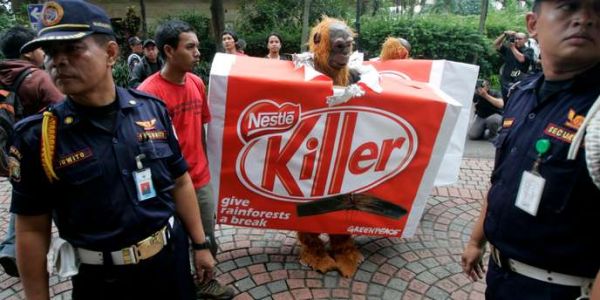
From inventing the need for mass-scale baby formula leading to the deaths of infants, to redirecting much needed water from impoverished areas to bottle and sell back to the same communities, to exploiting child labor and slavery, Nestlé will stoop to any moral low to make a buck.
[This article inaugurates Ms. Gjovik’s new column for CovertAction Magazine spotlighting the abuses of U.S. multinational corporations worldwide.—Editors]
Corporations like Nestlé are essentially doomsday machines: man-made creations that will ultimately destroy humanity if allowed to continue as they are. Multinational corporations are required by law to place the financial interests of shareholders above all other matters, even if that requires them to prioritize the bottom line above the common good. In this nightmare of our own creation, if it is more cost-effective for corporations to commit mass atrocities and pay a fine, than to not commit atrocities, the corporation is compelled to commit atrocities to ensure shareholder returns.
Further, this maximization of profit through unhinged business practices and investment tactics creates a cycle of destruction further fed by governments and institutions relaxing rules to entice companies to do business in ways that financially benefit that government. This enables the businesses to create more profit by cutting corners around labor rights, safety protections, and environmental standards. As negligence is further normalized, governments must entice businesses with more concessions, which encourages even worse behavior from corporations. Governments and business then race each other to the bottom in a destructive spiral that harms everyone.
In the Unites States, corporations claim a legal status as if they were human beings. While this is a fictional concept, if the corporation Nestlé were a person—Nestlé would be the worst kind of person, someone you would never want to be in the same room with. Nestlé is the American Psycho of corporations.
Yet, a company like Nestlé only exists because of the acquiescence and facilitation of its gross misconduct by governments and society. This case study on Nestlé’s business practices highlights some of the most egregious behavior by corporations.
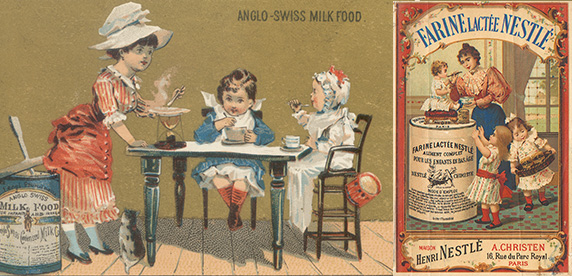
A Corporation Called Nestlé
Founded in 1866 by Henri Nestlé, today the Nestlé corporation owns more than 2,000 brands.[1] Nestlé is the world’s largest food company and is one of the most multinational of companies, with more than 450 manufacturing facilities in more than 79 countries, sales in 186 countries, and employment of 276,000 workers. In 2021, Nestlé reported $87 billion in sales and $22 billion in global profit. Around 30% of Nestlé’s total sales came from the United States, where Nestlé reported $26 billion in sales. [2]

The Nestlé name is widely associated with a controversy. Nestlé’s success is arguably due to its incredible brutality—from inventing the need for mass-scale baby formula leading to the deaths of infants, or redirecting much needed water from impoverished areas to bottle and sell back to the same communities, to exploiting child labor and slavery to gather ingredients for consumer products it admits have no nutritional value—Nestlé is an incredibly unethical company.
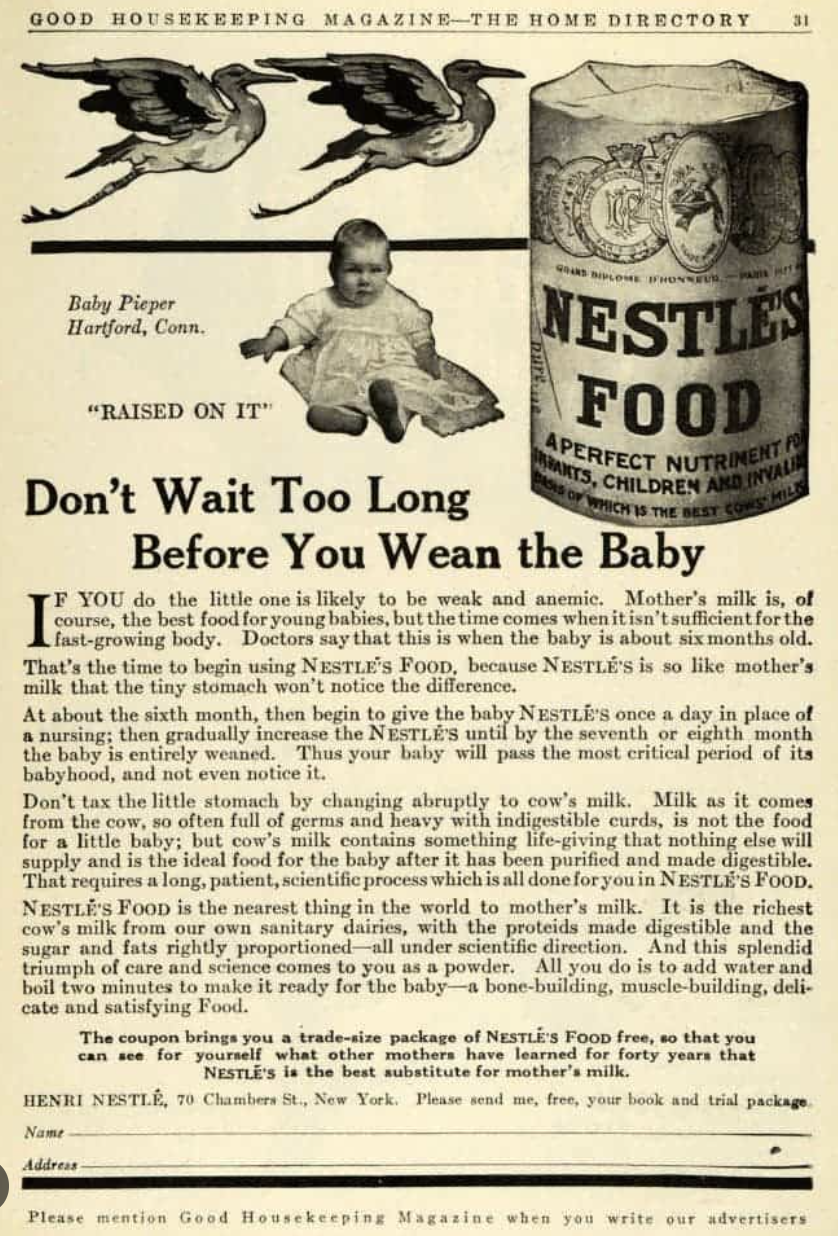
Yet, most of us probably regularly purchase Nestlé products, even if we think we avoid doing so. Nestlé’s owns an impressively extensive list of popular brand names including: Acqua Panna, Alpo, Beneful, Blue Bottle Coffee, Boost, Buitoni, Carnation, Cheerios, Coffee Mate, DiGiorno, Dreyer’s, Fancy Feast, Garden of Life, Gerber, Haagen Dazs, Hot Pockets, Kit Kat, Lean Cuisine, Nature’s Bounty, Nescafe, Nespresso, Nesquik, Ovaltine, Perrier, Purina, Pure Life, Stouffers, Starbucks Coffee at Home, Sweet Earth, San Pellegrino and Tombstone Pizza.[3]
Nestlé is also a major shareholder in L’Oréal, the multinational cosmetics conglomerate, which Nestlé reports as an “associate” on its financial reports.[4] L’Oréal itself owns many popular personal care brands like Lancôme, Garnier, Maybelline, Essie, Redkin, NYX, CeraVe, Urban Decay, and Kiehl’s.[5]
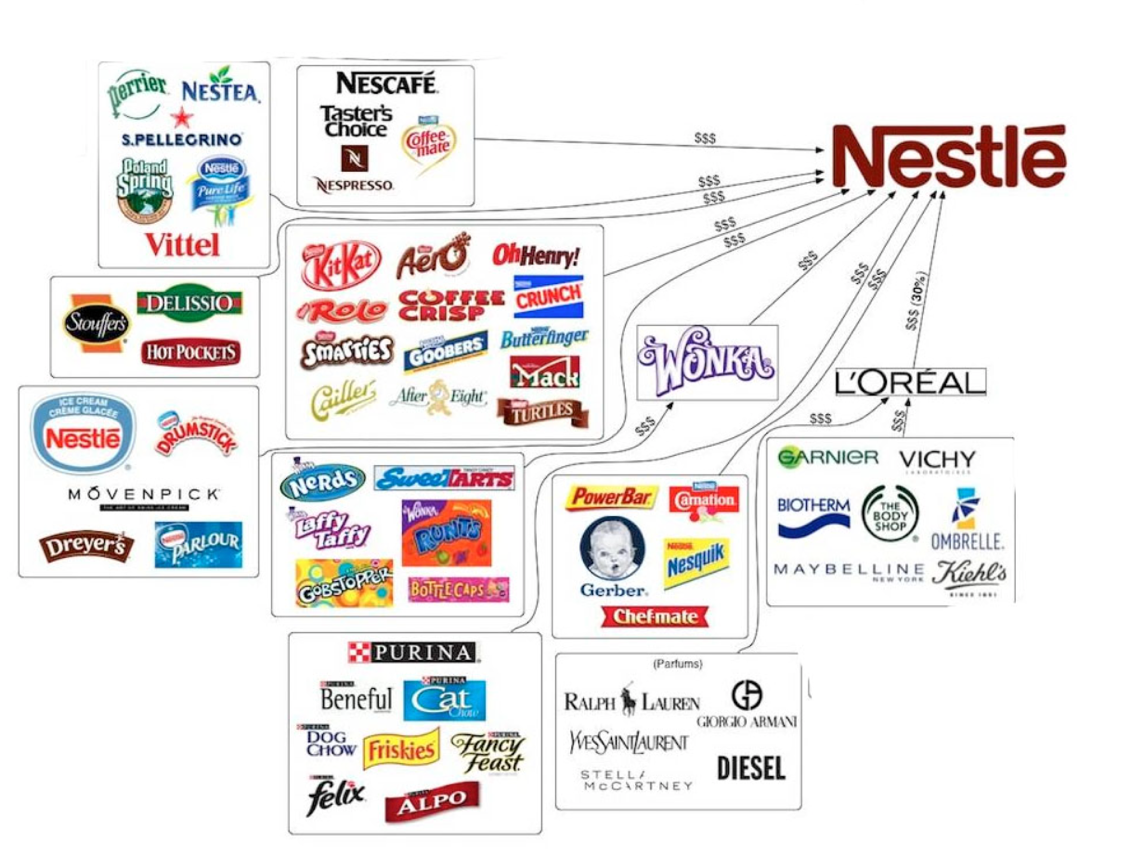
“Nestlé Kills Babies”
Nestlé’s most infamous scandal is around its baby formula products.
If mothers are able to breastfeed their babies, they are advised to provide their babies only breast milk for the first six months of life.[6] However, in the 1970s, Nestlé began sending representatives dressed as nurses to hospitals in impoverished countries to promote the company’s baby formula as replacement for breast milk, including sending families home with one free can. In these areas, the water that must be used to mix up the formula and clean the bottles was not safe.[7] Nestlé convinced these mothers to reject their own breast milk in favor of its infant formula.[8] Then, the mothers could not switch back to breastfeeding because, after one can, it was too late in the lactation cycle.

The result was an estimated one million dead babies every year from malnutrition or diseases contracted from dirty water or bottles.[9] In 1974, a report was published in Switzerland titled “Nestlé Kills Babies.”[10] All of this led to massive boycotts in the late 1970s and early 1980s. Nestlé insisted that the real problem was only access to water, while at the same time beginning to seize public waters for bottling and polluting the water that remained.[11]
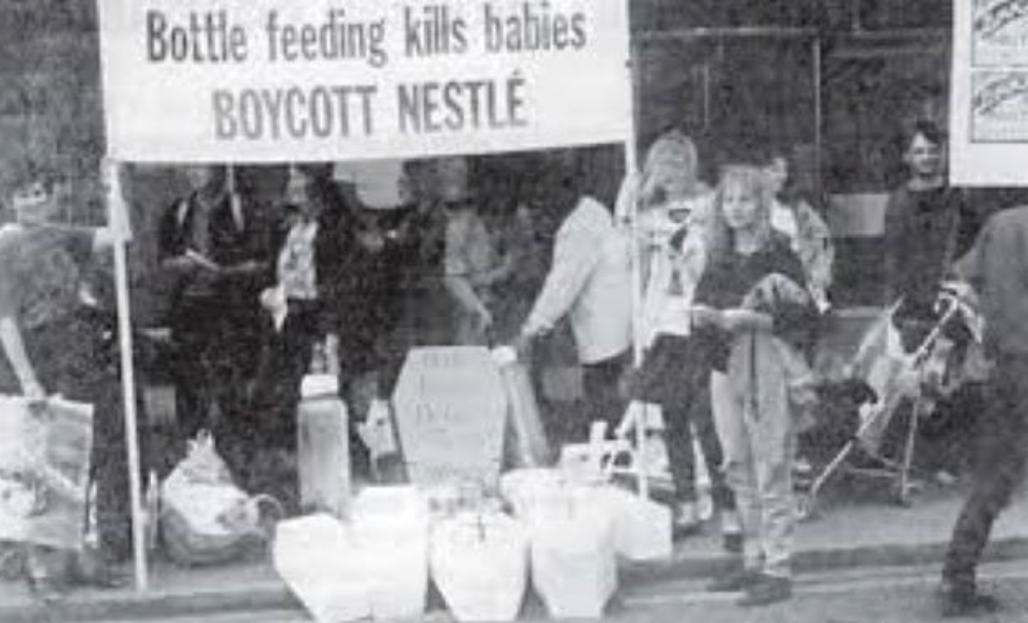

In May 2007, an investigation found evidence Nestlé was still engaging in questionable infant-formula marketing practices in Bangladesh.[12] Then in 2011, Nestlé was investigated for bribery in the Chinese baby formula market—including bribing medical staff to promote its infant formula to new mothers.[13]
Undeterred, in April 2012, Nestlé deepened its involvement in the market by purchasing Pfizer’s baby formula business (SMA) for more than $11 billion.[14] In 2019, Nestléʼs own report still found at least 107 instances of non-compliance with international baby milk marketing rules.[15]
Last year, the World Health Organization and UNICEF issued a report finding ongoing “extensive and aggressive marketing practices used by the formula milk industry to target new and prospective parents” which “exploit emotions, the fears and the ambitions of women and families at a time they’re potentially most vulnerable.”[16] Nestléʼs baby formula practices are a stunning example of free-market murder over decades.
Bottling the Commons
In poor regions, Nestlé and others have been taking water from aquifers, springs, rivers and lakes—and putting it in plastic bottles or turning it into flavored and sugary drinks—then dumping their used and dirty water back into water sources. Locals are then not able to drink tap water and end up paying extortionate prices to the European and U.S. corporations for bottled versions of their own previously uncontaminated tap water.[17] In 2020, Nestlé reported $6.4B in bottled water sales.[18]
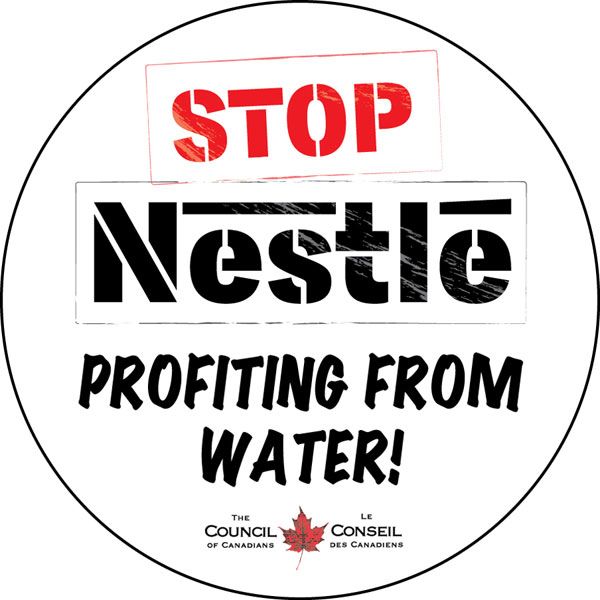
For years, activists have accused Nestlé of lining its own pockets through back-door privatization of public water supplies. Access to water is a human right.
Corporate privatization of the commons seizes a public resource and converts it to a private good, and Nestlé has been implicated in this for decades. In fact, the source of America’s corporate water crisis can be traced back to 1976 when Perrier opened an office in New York.[19] The firm partnered with a U.S. executive who had recently left Levi Strauss, and they built a marketing campaign to convince Americans to pay for water.[20]
Nestlé acquired Perrier in 1992 for $2.6B.[21] At that time, Perrier had issued a recall due to reports of benzene in the bottled water and also faced a fine in New York for false advertising.[22] Perrier was apparently a culture fit for Nestlé.
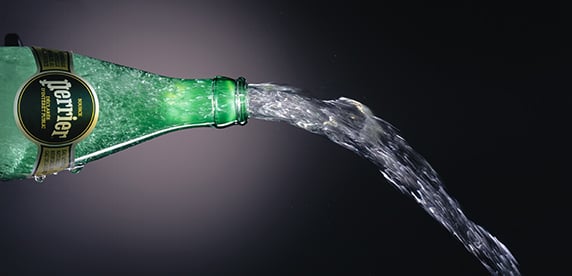
By 2016, bottled water sales had surpassed soda as the largest U.S. beverage category, with Americans consuming 12.8B gallons that year.[23] In addition to seizing public waters, Nestlé’s manufacturing process uses far more water than the output provides (only about 70%). Meanwhile, Nestlé also dumps a significant amount of now polluted water back into water basins and aquifers.[24]
While other companies moved their operations out of drought-ridden California, Nestlé’s CEO said he would pump more out of the San Bernardino National Forest if he could. Nobody actually knows how much Nestlé extracts from this source—which it has been doing without a permit since 1988—paying only $524 a year to bypass the requirement.[25] In 2021, California’s Water Resources Control Board asked Nestlé to stop the unauthorized water diversions after a probe revealed multiple violations and depleted resources.[26]
Nestlé has shown no shame or contrition for any of this. In fact, former Nestlé chief executive and chairman Peter Brabeck called water a “grocery product” that should “have a market value.” He later amended that, arguing water can be a human right, but only 25 liters a day.[27] Today, Nestlé’s website continues to argue that “non-essential” use of water is not a human right and should “carry a cost.”[28]
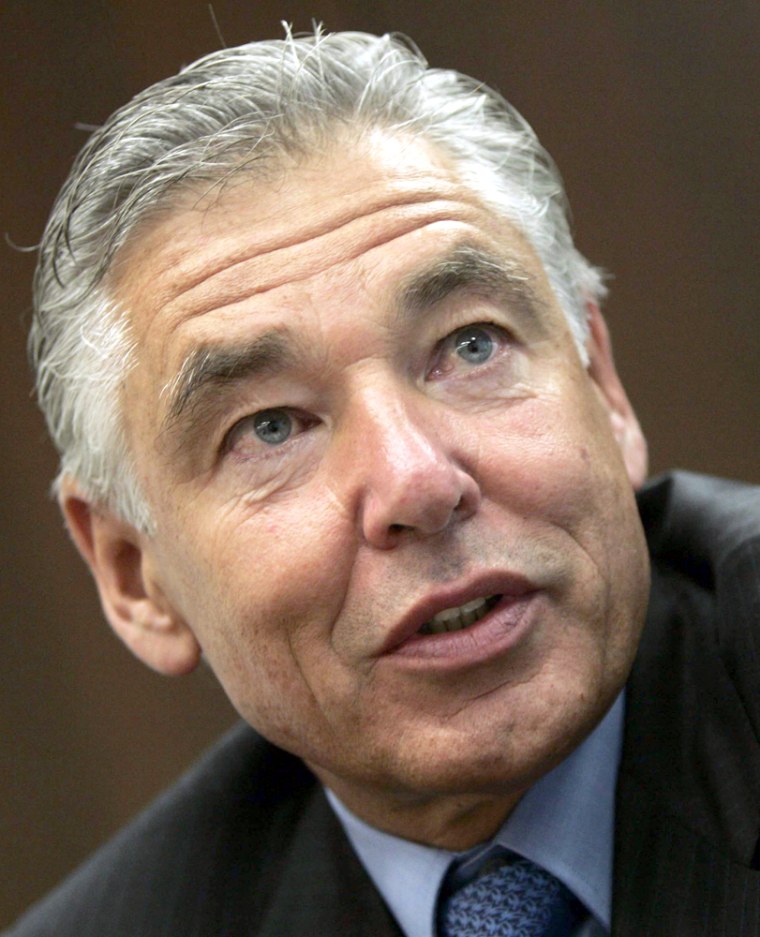
Slavery-made
Nestlé’s unlawful business practices are not limited to fatally unethical marketing. Nestlé has also been implicated in child labor, human trafficking and slavery—for decades.
The U.S. Department of Labor reports that more than 1.5 million children work in the cocoa industry in Ghana and the Ivory Coast, which produce 60% of the world’s annual cocoa harvest. More than 40% of those children are exposed to dangerous working conditions, including chemical usage, burning fields, swinging machetes, and heavy lifting—activities that international authorities consider the “worst forms of child labor.”[29]
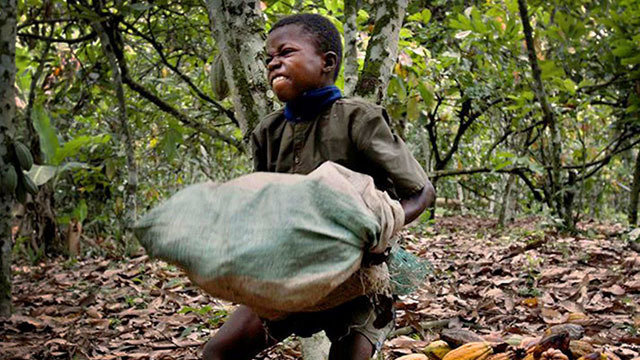
In Nestlé USA v. Doe (2021), former child slaves who were trafficked into Côte d’Ivoire to work on cocoa farms filed suit under the Alien Tort Statute (ATS) against Nestlé USA.[30] They accused the corporation of aiding and abetting the illegal enslavement of thousands of children on cocoa farms in Nestlé’s supply chains.[31]
Nestlé USA effectively controls much of the cocoa production in the Ivory Coast and operates “with the unilateral goal of finding the cheapest source of cocoa in the Ivory Coast,” resulting in a “system built on child slavery to depress labor costs.”[32] Nestlé knowingly profited from the illegal work of children and Nestlé’s contracted suppliers were able to provide lower prices than if they had employed adult workers with proper protective equipment.[33]
In Nestlé’s Petition for Certiorari, Nestlé’s lawyers did not deny there was slavery in its supply chain but instead argued, among other things, that corporations cannot be liable for violations of customary international law or human rights violations.[34] Nestlé lawyers extensively referenced the Nuremberg Trials in their argument for impunity, desperately pleading that even the corporation that supplied Zyklon B gas, which the Nazis used to kill millions, was not convicted during that trial.[35]
During oral arguments, the U.S. Justice Department, on behalf of the U.S. government, supported Nestlé. Deputy Solicitor General Curtis E. Gannon contended that a new act of Congress would be needed to create liability for domestic corporations under the ATS (liability which the lawyer described as corporations being “discriminated against”).[36] Gannon, on behalf of the United States, said the case against Nestlé alleging child slavery could “threaten foreign affairs interests” for the U.S. government.[37]

Upon inquiry from Chief Justice John Roberts as to whether the U.S. government believes a corporation could ever be liable for setting up a U.S. corporation and sending U.S. employees to the Ivory Coast for the express purpose of setting up a cocoa farm that uses child slavery, Gannon responded, “Well, I think that it—it depends on how much conduct happens in the United States and how much conduct happens overseas.” [38]
Deputy Solicitor General Curtis Gannon, the U.S. government’s lawyer, famously authored the Justice Department memorandum approving President Trump’s “Muslim Ban” (Executive Order 13769) in 2017, when he was Principal Deputy Assistant Attorney General for DOJ’s Office of Legal Counsel. Before joining the Justice Department, Gannon worked at the infamous union-busting firm Gibson, Dunn & Crutcher.[39]

Nestlé USA v. Doe was dismissed in favor of Nestlé. The decision was the latest in a series of U.S. rulings imposing strict limits on lawsuits brought in federal court based on human rights abuses abroad.[40] To make matters worse, which is only possible with the depravity of a corporation like Nestlé, the company was also alleged to have orchestrated a chocolate price-fixing conspiracy, violating antitrust laws in the sales of its products manufactured with child slave labor.[41]
Nestlé’s human slavery supply chain is not exclusive to chocolate. In 2020, a documentary exposed Nespresso’s supply chain use of child labor on Guatemalan farms.[42] The documentary visited seven farms linked to Nespresso and found children working eight hours a day, six days a week, and who looked as young as eight years old.[43]
Earlier, investigations also found migrants were lured by false promises to work in Thailand’s seafood sector, then kept in debt bondage and degrading conditions. When workers died on the job, it said the bodies were simply “thrown into the water.” In 2014, Nestlé confirmed the forced labor was part of its supply chain in Thailand.[44]
Waste… All the Way Down
Nestlé’s misconduct also includes degradation of the environment and a direct role in causing the current climate crisis.
Nestlé’s plastic packaging is produced from plastic resin created by petrochemical companies like Exxon, Total, Aramco and Shell. The process of manufacturing plastic, as well as the extraction of the raw materials for it, releases enormous amounts of carbon dioxide, approximately 108M metric tons per year.[45]
Plastic also enters into the product. Concentrations of microplastic in bottles of Nestlé Pure Life water were as high as 10,000 pieces of plastic per liter of water, the highest of any brand tested.[46] Some of the microplastics the researchers found in Nestlé’s water included polypropylene, nylon, and polyethylene terephthalate.[47] Nestlé was sued in 2018 over the high levels of microplastics, with plaintiffs alleging Nestlé “intentionally, negligently and recklessly concealed and omitted the truth” about the plastic contamination.[48]
Nestlé released a statement saying that it had “ambitions” for its packaging to be 100% recyclable or reusable by 2025. However, environmental groups and other critics pointed out that Nestlé had not released clear targets or a timeline to accompany its ambitions, nor made additional efforts to help facilitate recycling by consumers. [49] Greenpeace released a statement saying, “Nestlé’s statement on plastic packaging includes more of the same greenwashing baby steps to tackle a crisis it helped to create. It will not actually move the needle toward the reduction of single-use plastics in a meaningful way, and sets an incredibly low standard as the largest food and beverage company in the world.”[50]

In the organization “Break Free From Plastic”’s 2020 report, Nestlé was named one of the world’s top plastic polluters for the third year in a row.[51] Nestlé even admitted that most of its bottles are not recycled, even while Nestlé concurrently flooded the market with misleading advertisements claiming the opposite. Only about 31% of plastic bottles end up getting recycled, creating millions of tons of garbage every year, much of which ends up in landfills or the ocean.[52]
A single plastic bottle can take anywhere from 450 to 1,000 years to decompose in a landfill.[53]
After so much controversy, Nestlé largely divested from its North American water-bottling hustle, selling most of the business in 2021.[54] While Nestlé is no longer the face of the U.S. bottled water problem, it is still responsible for the damage to the environment and the terrible systems it put in place.
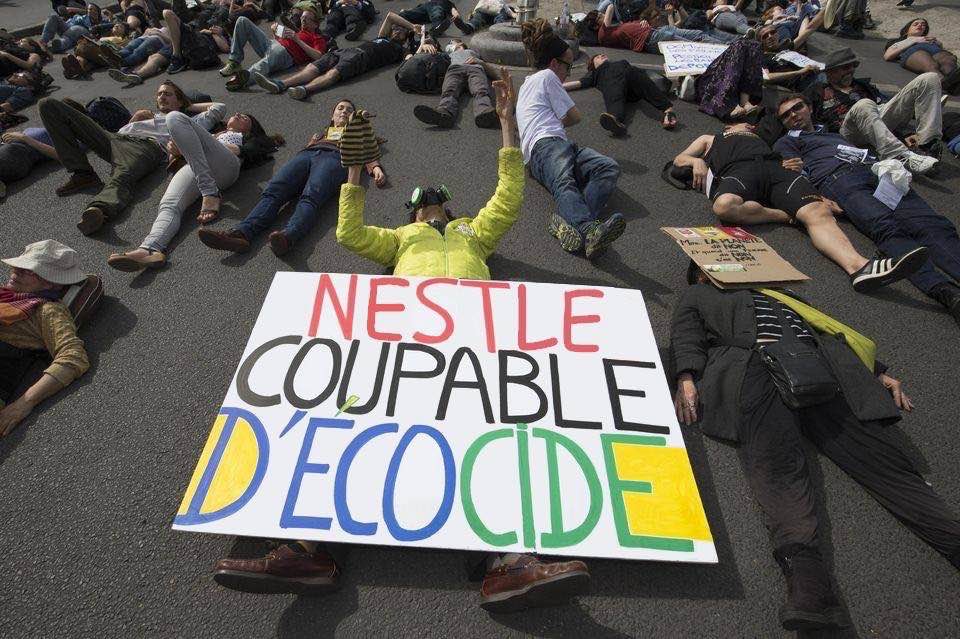
Nestlé was also caught purchasing palm oil from mills with reckless means of production, including chopping down millions of hectares of forests and removing Indigenous peoples from their lands.[55] In 2010, Greenpeace campaigned for Nestlé to end deforestation in its supply chain.
Nestlé promised to do so by 2015, but in 2017 Nestlé noted 47% of its palm oil still came from problematic plantations.[56] Then in 2019, Nestlé was also accused of sourcing palm oil from producers linked to the forest fires in Indonesia.[57] A recent Global Witness report documented the still ongoing harm, terror and impoverishment of communities due to corporate pursuit of palm oil, including by Nestlé.[58] Rest assured, Nestlé still claims to be “working hard” on the issue.[59]
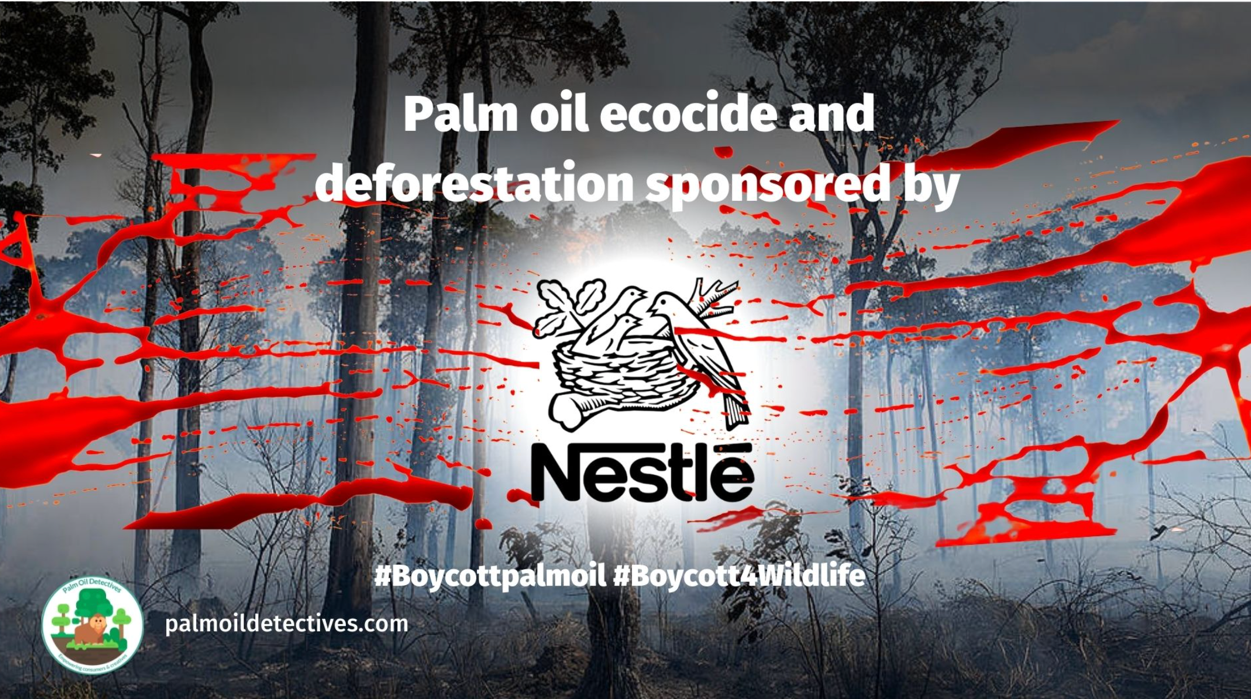
Further, a former Nespresso executive warned in 2016 that Nespresso pods create extensive waste. Made from a combination of plastics and aluminum, the coffee pods are not biodegradable. It can take between 150 to 500 years for the aluminum and plastic capsules to break down in a landfill. In order to recycle the pods, the aluminum capsules have to be shredded, the coffee has to be taken away with water, the varnish has to be burned and the aluminum has to be re-smelted.[60]
Nespresso capsules are not pure aluminum due to Nestlé’s intellectual property and anti-competitive interests: The capsules contain silicon as part of a patent which was used to prevent rivals from making their own pods that could work in Nespresso machines.[61] As of 2019, 70% of Nespresso pods were assumed to be headed to landfills.[62]

L’Oréal has its own shameful history, starting with the company’s founder, known Nazi sympathizer Eugène Schueller.[63]
L’Oréal faced protests and boycotts due to testing cosmetics on animals,[64] suspected use of child labor to obtain mica for cosmetics,[65] deceptive advertising,[66] and high levels of lead in lipstick products.[67]
L’Oréal also allegedly uses carcinogenic and endocrine-disrupting chemicals in its beauty products, including: formaldehyde, PFOAs, carbon black, titanium dioxide, BHA and others.[68] L’Oréal is currently facing numerous lawsuits over PFAS contents in its beauty products.[69]

Nestlé’s food products have also been found to contain not just toxic chemicals, but also low-quality filler products, including a “horsemeat” scandal in one of its pasta brands in 2013.[70]
A Friend of Paramilitaries
Nestlé apparently does not care who it harms with its supply chain or marketing, so why would labor rights be any different?
In the U.S., the National Labor Relations Board’s public database shows 169 Unfair Labor Practice charges filed against Nestlé (though there may be more under the names of other subsidiaries).[71]
In one recent case, the NLRB found against Nestlé USA in 2020, issuing an order against the corporation for unfair labor practices at a Wisconsin facility that produces DiGiorno pizza.[72]
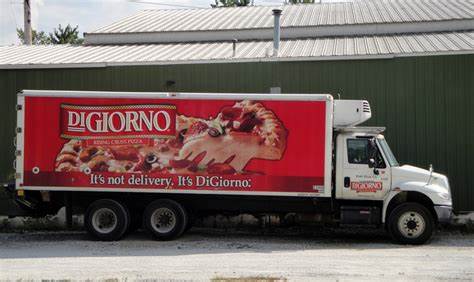
The NLRB ordered Nestlé USA to cease and desist from, among other things: coercively interrogating employees about their protected concerted activities, and suspending or discharging employees because they engage in protected concerted activities.” [73] The Board ordered Nestlé to post a notice to employees admitting it violated federal labor laws and promising to follow federal labor laws going forward. [74]
The year before, a report by AFL-CIO alleged that Nestlé had been involved in several workers’ rights abuses, that Nestlé USA management had continually interfered with workers’ organizing rights, and Nestlé was involved in anti-union campaigning.[75]
Nestlé’s union busting is deadly in South America. A Colombian trade unionist, Luciano Romero, campaigned for the rights of workers at Nestlé’s factory in Colombia for years, including documenting violations of human rights at the factory. Before his murder, Romero was repeatedly falsely branded as a guerrilla fighter by the local representatives of Nestlé. He was also accused, without grounds, of being responsible for a bombing on the factory premises in 1999. In Colombia, a defamation of this kind can effectively amount to a death sentence.[76]
In September 2005, Luciano Romero was stabbed 50 times in a murder by paramilitaries.[77]
In 2006, Nestlé and the paramilitary members were sued for the murder of Romero, as the company had a long-standing relationship with the paramilitary forces and Romero’s widow alleged the murder was in retaliation for his blowing the whistle on Nestlé’s use of expired milk in its popular Milo brand drink.[78]
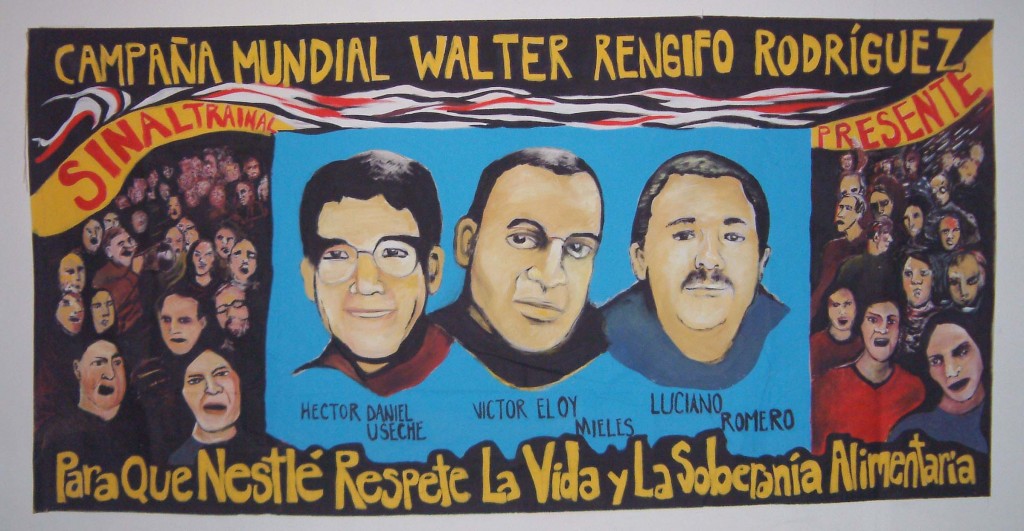
In 2007, Romero’s killers were convicted and, while passing sentence, the judge also ordered an investigation into the role of management at the Nestlé subsidiary where Romero worked.[79] A criminal complaint was filed against Nestlé in Swiss courts in 2012, but then dismissed in 2013 due to the statute of limitations having expired.[80] The European Center for Constitutional and Human Rights then submitted a complaint calling on the European Court of Human Rights to examine the judiciary that dismissed the complaint, which was also promptly dismissed.[81]
In 2012, a flyer was left at the home of Rafael Esquivel, another Nestlé labor union leader, with a death threat stating “you will have to be exterminated, you have until first December to disappear from Valle, otherwise you will see blood running on second December.”[82] In 2013, more death threats were sent to dozens of trade union members and human rights defenders, including other members of a Nestlé labor union.[83]
In 2013, the same trade union Romero had worked with accused Nestlé of ordering the murder of Oscar López Trevino, who had worked for the company for 25 years. Trevino was shot and killed by paramilitaries that year, following the initiation of a hunger strike campaign by workers against Nestlé over unfulfilled labor agreements.[84]

Today, Nestlé has a page on its website entitled “Does Nestlé allow labor unions?” which Nestlé answers: “Nestlé supports collective dialogue and negotiations with employee unions…wherever local legislation applies…Nestlé suppliers should allow Freedom of Association and Collective Bargaining, unless government policies or other norms prevent them from doing so.”
Nestlé’s own website says it does not believe suppliers need to allow for human rights if it is contrary to local “norms.”[85]
Spying on Critics
Nestlé is just as bad with its critics. In 2003, Nestlé used a private security company to infiltrate the anti-globalization group ATTAC. Nestlé planted a spy who joined ATTAC’s editorial board and monitored ATTAC’s research and drafting of a book criticizing Nestlé’s practices that was published in 2004 (“Attac Contre L’Empire Nestlé”).[86] The spy even attended workgroup meetings at members’ homes.[87]
The spy was employed by a company called Securitas and run by a former MI6 officer working for Nestlé. ATTAC took legal action over the breach and expressed concern that trade unionists at Nestlé sites in Colombia who have been targeted by paramilitaries may have been put in danger.[88] Nestlé was found liable for the spying and a Swiss court ordered Nestlé and its security company to pay compensation .[89]
Just this year, Nestlé was caught offering “quid pro quos” to the Academy of Nutrition and Dietetics, an influential U.S. policy group.[90] Nestlé was identified as a top “contributor,” sending the policy group hundreds of thousands of dollars.[91]
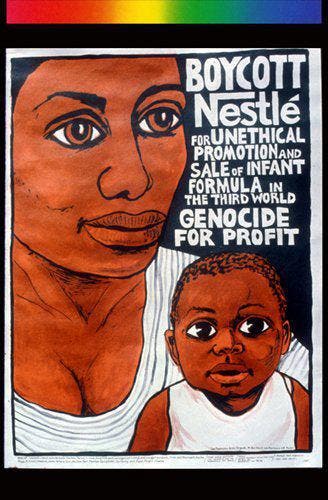
Taking Until There Is Nothing Left
There appears to be no line that Nestlé is unwilling to cross, with a key example being Ethiopia.
Following 30 years of wars and famines, the people of Ethiopia were suffering terribly in the 1990s.[92] Nestlé acquired a company whose subsidiary was nationalized by the Ethiopian government in 1975 (decades prior) and then sold in 1998.[93]
In 2001, despite the struggles in Ethiopia, Nestlé filed a claim for $6 million from the Ethiopian government, “as a matter of principle.”[94] $6 million is only 0.01% of Nestléʼs annual sales, but would be a devastating loss to an already struggling country.[95] Nestlé eventually reduced the request to $1.5M following public outrage.[96]
Conclusion
Nestlé’s rebuttal to most accusations of misconduct is essentially to claim it is an ethical, caring and child-friendly teddy-bear of a transnational corporation which just does not know what goes on in its supply chain and always wants to do better, but is constantly harassed by hateful critics. When caught red-handed, Nestlé is then willing to point to IG Farben and use the legal precedent from the Holocaust to argue why it should be granted impunity for egregious human rights abuses.
Since 2000, only considering the United States, Nestlé and its subsidiaries were cited for more than a hundred legal violations, facing $27 million in fines.[97] One must ask: Is all of this misconduct and devastation contributing to anything actually beneficial to society? No. Nestlé, a food company, has recently acknowledged that more than 60% of its food and drink products do not meet a “recognized definition of health” and that some products “will never be healthy.”[98] Nestlé does not even sell food with nutritional value. Nestlé sells terrible ideas and filler, produced through human rights violations, but which drive billions in profit for the soulless corporation.
However, as terrible as Nestlé is, it is only one head of the corporate hydra. There are many others. We can talk about protests and boycotts—we can write exposés and file lawsuits—but this only attempts to hold the line. To actually stop the downward spiral, we must abolish the atrocity of capitalism and globalization that is the multinational corporation.
While claiming corporations have the rights of a human, yet also requiring these corporations to only prioritize shareholder profit and pleasure, we have created a demented Dionysian monster that happily views fiscal opportunity in the destruction of humanity.
We cannot sit back and hope the United States will intervene for the benefit of the common good. When the democratically elected government of Guatemala decided to impose obligations on real estate owned by the United Fruit Company, the U.S. violently overthrew that government. When Chile elected a socialist president who wanted to nationalize copper mines, that democratic government was destroyed by the U.S. and replaced with a dictatorship headed by General Augusto Pinochet.[99] The U.S. has a long history of siding with corporate interests at all costs.

With Nestlé, the United States has already worked to fight lawsuits and dismiss charges attempting to hold Nestlé accountable for horrendous human rights violations. The U.S. is apparently happy to race to the bottom, hand-in-hand with these monstrous corporations. The corporation and the state have already become one institution, with extensive centralized economic power, and increasingly destructive behavior.
We need a global awakening and revolution by the people. As Johann Wolfgang von Goethe said in 1809: “None are more hopelessly enslaved than those who falsely believe they are free.” We are not free and together we are our only hope to stop this downward spiral of environmental degradation and human rights abuses.

-
“The Case Against Nestlé,” Lakota People’s Law Project, June 14, 2018, https://lakotalaw.org/news/2018-06-13/the-case-against-Nestlé ↑
-
Nestlé,“Corporate Governance Report 2021; Compensation Report 2021; Financial Statements 2021” (“Corporate Governance Report 2021”), 2022, https://web.archive.org/web/20230106174601/https://www.nestle.com/sites/default/files/2022-03/2021-corp-governance-compensation-financial-statements-en.pdf ↑
-
“Brands,” Nestlé, https://www.Nestle.com/brands; “Brands,” Nestlé USA, https://www.Nestléusa.com/brands ↑
-
Nestlé, “Corporate Governance Report 2021.”. ↑
-
L’Oréal, “Our Global Brands,” https://web.archive.org/web/20230106174728/https://www.loreal.com/en/our-global-brands-portfolio/ ↑
-
World Health Organizattion, “Breastfeeding,” https://www.who.int/health-topics/breastfeeding ↑
-
Stephen Solomon, “The Controversy Over Infant Formula,” The New York Times Magazine, December 6, 1981, https://www.nytimes.com/1981/12/06/magazine/the-controversy-over-infant-formula.html ↑
- Martha Rosenberg, “Big Food Wants You To Believe Obesity is Caused by Lack of Exercise not Junk Food and the Spin Is Working,” CounterPunch, August 24, 2018, https://www.counterpunch.org/2018/08/24/big-food-wants-you-to-believe-obesity-is-caused-by-lack-of-exercise-not-junk-food-and-the-spin-is-working/
-
Solomon, “The Controversy Over Infant Formula.” ↑
-
“The Build Up to the Nestlé Boycott,” The Boycott Book, http://www.theboycottbook.com/thebuildup.pdf ↑
-
Solomon, “The Controversy Over Infant Formula.” ↑
-
Joanna Moorhead, “Milking It,” The Guardian, May 15, 2007, http://www.guardian.co.uk/business/2007/may/15/medicineandhealth.lifeandhealth ↑
-
Chris Zhang, “Where Is China’s Corruption Crackdown,” The Diplomat, July 21, 2017, https://thediplomat.com/2017/07/where-is-chinas-corruption-crackdown/ ↑
-
Nestlé, “Nestlé completes acquisition of Pfizer Nutrition, enhancing its position in global infant nutrition,” December 1, 2012, https://web.archive.org/web/20230106174831/https://www.nestle.com/media/pressreleases/allpressreleases/pfizer-nutrition-closing ↑
-
Nestlé, ““Leading the Way: Responsible Marketing of Breast Milk Substitutes, 2019 Report,” 2020, https://web.archive.org/web/20230106174835/https://www.nestle.com/sites/default/files/2020-08/who-code-compliance-annual-report-2019.pdf ↑
-
World Health Organization, “Ending exploitative marketing of formula milk,” February 23, 2022, https://www.who.int/teams/maternal-newborn-child-adolescent-health-and-ageing/formula-milk-industry; Swissinfo, “WHO Slams Baby Milk Industry,” https://www.swissinfo.ch/eng/business/who-slams-baby-milk-industry-for-rampant–manipulative–marketing/47369706 ↑
-
Tamara Pearson, “The Horrific Scam That Water Billionaires Are Running on Poor Countries,” CounterPunch, March 21, 2022, https://www.counterpunch.org/2022/03/21/the-horrific-scam-that-water-billionaires-are-running-on-poor-countries/ ↑
-
Nestlé, “Corporate Governance Report 2021.” ↑
-
Tom Perkins, “The Fight to stop Nestlé from taking America’s water to sell in plastic bottles,” The Guardian, October 29, 2019, https://www.theguardian.com/environment/2019/oct/29/the-fight-over-water-how-nestle-dries-up-us-creeks-to-sell-water-in-plastic-bottles ↑
-
Elizabeth Whitman, “The Ad Campaign that Convinced Americans to Pay for Water,” Priceonomics, June 10, 2016, https://priceonomics.com/the-ad-campaign-that-convinced-americans-to-pay/ ↑
-
George White,“$2.6-Billion Nestle Bid Ends Battle for Perrier,” Los Angeles Times, March 25, 1992, https://www.latimes.com/archives/la-xpm-1992-03-25-fi-4379-story.html ↑
-
George James, “Perrier Recalls Its Water in U.S. After Benzene Is Found in Bottles,” The New York Times, February 10, 1990, https://www.nytimes.com/1990/02/10/us/perrier-recalls-its-water-in-us-after-benzene-is-found-in-bottles.html; “Perrier Pays New York $40,000 in Labeling Inquiry,” The New York Times, August 21, 1991, https://www.nytimes.com/1991/08/21/garden/perrier-pays-new-york-40000-in-labeling-inquiry.html ↑
-
Perkins, “The Fight to stop Nestlé from taking America’s water to sell in plastic bottles .” ↑
-
Pearson, “The Horrific Scam That Water Billionaires Are Running on Poor Countries” ↑
-
Mohammed Hanif, “Let Them Drink Bottled Water,” The New York Times, November 23, 2018, https://www.nytimes.com/2018/11/23/opinion/pakistan-water-contamination-bottled.html ↑
-
“Nestle asked to stop spring water diversions in San Bernardino,” Reuters, April 23, 2021, https://www.reuters.com/business/environment/nestle-asked-stop-spring-water-diversions-san-bernardino-2021-04-23/ ↑
-
Perkins, “The Fight to stop Nestlé from taking America’s water to sell in plastic bottles.” ↑
-
Nestlé, “Does Peter Brabeck-Letmathe believe that water is a human right?” https://www.Nestlé.com/ask-Nestlé/human-rights/answers/Nestlé-chairman-peter-brabeck-letmathe-believes-water-is-a-human-right ↑
-
Lela Tolajian, “Your Halloween chocolate may have been harvested by children forced to work in Africa,” USA Today, October 29, 2022, https://www.usatoday.com/story/opinion/2022/10/29/halloween-candy-chocolate-may-tainted-forced-child-labor/7896991001/ ; Peter Whoriskey and Rachel Siegel, “Cocoa’s child laborers,” The Washington Post, June 5, 2019, https://www.washingtonpost.com/graphics/2019/business/hershey-nestle-mars-chocolate-child-labor-west-africa/ ↑
-
“U.S. Supreme Court Holds Claims Against U.S. Corporations for Aiding and Abetting Child Slavery Impermissibly Extraterritorial, Declines to Resolve Domestic Corporate Liability,” American Journal of International Law, 2021, Vol. 115 Issue 4, pp. 739-44. ↑
-
Oliver Balch, “Mars, Nestlé and Hershey to face child slavery lawsuit in US,” The Guardian, February 12, 2021, https://www.theguardian.com/global-development/2021/feb/12/mars-Nestle-and-hershey-to-face-landmark-child-slavery-lawsuit-in-us ↑
-
“Nestlé USA v. Doe,” Oyez, 2020, https://www.oyez.org/cases/2020/19-416 ↑
-
Oliver Balch, “Mars, Nestlé and Hershey to face child slavery lawsuit in US.” ↑
-
Nestlé USA v. Doe, On Petition for a Writ of Certiorari to the United States Court of Appeals for the Ninth Circuit (2015). ↑
-
Peter Whoriskey, “Supreme Court weighs child-slavery case against Nestlé USA, Cargill,” The Washington Post, December 1, 2020, https://www.washingtonpost.com/business/2020/12/01/cocoa-supreme-court-child-labor/; Nestlé USA v. Doe, On Petition for a Writ of Certiorari to the United States Court of Appeals for the Ninth Circuit (2015). ↑
-
Nestlé USA v. Doe, U.S. Supreme Court, No. 19-416, Oral Arguments, December 1, 2020, https://www.supremecourt.gov/oral_arguments/argument_transcripts/2020/19-416_dc8f.pdf ↑
-
Nestlé USA v. Doe, U.S. Supreme Court, No. 19-416, Oral Arguments, December 1, 2020. ↑
-
Nestlé USA v. Doe, U.S. Supreme Court, No. 19-416, Oral Arguments, December 1, 2020. ↑
-
Ryan J. Reilly, “DOJ Releases Legal Memo That Approved Trump’s Refugee Ban,” HuffPost, February 2, 2017, https://www.huffpost.com/entry/olc-memo-refugee-ban_n_5893ac35e4b09bd304ba74d9 ↑
-
Adam Liptak, “Supreme Court Limits Human Rights Suits Against Corporations,” The New York Times, June 17, 2021, https://www.nytimes.com/2021/06/17/us/supreme-court-human-rights-nestle.html ↑
-
Jeff Gray, “Former Nestlé Canada CEO may face chocolate price-fixing charge ‘shortly,’” Globe and Mail, December 5, 2012, https://www.theglobeandmail.com/report-on-business/industry-news/the-law-page/former-nestle-canada-ceo-may-face-chocolate-price-fixing-charge-shortly/article6013249/ ↑
-
Nestlé, “What is the response to allegations from the Dispatches TV documentary of child labor on Nespresso-associated farms in Guatemala?” https://web.archive.org/web/20230106180444/https://www.nestle.com/ask-nestle/human-rights/answers/channel-4-dispatches-guatemala-child-labor-allegations-nespresso ↑
-
Jamie Doward, “Children as young as eight picked coffee beans on farms supplying Starbuck,” The Guardian, March 1, 2020, https://www.theguardian.com/business/2020/mar/01/children-work-for-pittance-to-pick-coffee-beans-used-by-starbucks-and-nespresso ↑
-
Katie Nguyen, “Campaigners hope others follow Nestle in admitting and acting on slave labour in its products,” Reuters, November 24, 2015, https://www.reuters.com/article/nestle-seafood-idUSL8N13J3YV20151124; Annie Kelly, “Nestlé admits slavery in Thailand while fighting child labour lawsuit in Ivory Coast,” The Guardian, February 1, 2016, https://www.theguardian.com/sustainable-business/2016/feb/01/nestle-slavery-thailand-fighting-child-labour-lawsuit-ivory-coast; Kate Hodal, Chris Kelly, and Felicity Lawrence, “Revealed: Asian slave labour producing prawns for supermarkets in US, UK,” The Guardian, June 10, 2014, https://www.theguardian.com/global-development/2014/jun/10/supermarket-prawns-thailand-produced-slave-labour ↑
-
SumOfUs, “Nestlé : the 3rd biggest polluter on the planet,” 2022, https://web.archive.org/web/20230106180854/https://actions.sumofus.org/a/nestle-the-4th-biggest-polluter-on-the-planet; Break Free From Plastic, “Branded: Brand Audit Report 2021,” https://www.breakfreefromplastic.org/wp-content/uploads/2021/10/BRAND-AUDIT-REPORT-2021.pdf; Center for International Environmental Law, “Plastic & Climate: The Hidden Costs of a Plastic Planet,” May 2019, https://www.ciel.org/reports/plastic-health-the-hidden-costs-of-a-plastic-planet-may-2019/ ↑
-
Graham Readfearn, “WHO launches health review after microplastics found in 90% of bottled water,” The Guardian, March 14, 2018, https://www.theguardian.com/environment/2018/mar/15/microplastics-found-in-more-than-90-of-bottled-water-study-says ↑
-
Martin Macias, Jr., “Nestle’s ‘Pure Life’ Water Filled With Plastic, Class Says,” Courthouse News, April 13, 2018, https://www.courthousenews.com/nestles-pure-life-water-filled-with-plastic-class-says/ ↑
-
Macias, “Nestle’s ‘Pure Life’ Water Filled with Plastic, Class Says.” ↑
-
Deena Robinson, “10 Companies Called Out For Greenwashing,” Earth, July 17, 2022, https://earth.org/greenwashing-companies-corporations/ ↑
-
Perry Wheeler, “Nestlé misses the mark with statement on tackling its single-use plastics problem,” Greenpeace, April 10, 2018, https://www.greenpeace.org/usa/news/nestle-aiming-at-100-recyclable-or-reusable-packaging-by-2025/ ↑
-
Break Free From Plastic, “Branded: Global Audit Report.” ↑
-
Bruce Watson, “The troubling evolution of corporate greenwashing,” The Guardian, August 20, 2016, https://www.theguardian.com/sustainable-business/2016/aug/20/greenwashing-environmentalism-lies-companies ↑
-
Heather Kohlmann, “‘Environmentally friendly’ bottled water? No such thing,” This, May 15, 2009, https://this.org/2009/05/15/environment-water-bottle/ ↑
-
“Groups Challenge Nestlé’s Bottled Water ‘Greenwashing,’” Polaris Institute, December 2, 2008, https://web.archive.org/web/20141022031038/http:/www.polarisinstitute.org/groups_challenge_nestl%C3%A9%E2%80%99s_bottled_water_greenwashing [NOTE: I couldn’t find this under “Polaris Institute” although I did find it under “web.archive” source. However, the “web archive” source is dated 2014 while the original article, which I found under “Common Dreams,” is dated December 2, 2008. I would use the following source rather than “web archive, etc.”: https://www.commondreams.org/newswire/2008/12/01/groups-challenge-nestles-bottled-water-greenwashing ] ↑
-
“The Case Against Nestlé,” Lakota People’s Law Project. ↑
-
Arthur Neslen,“Nestlé, Hershey and Mars ‘breaking promises over palm oil use,’” The Guardian, October 28, 2017, https://www.theguardian.com/environment/2017/oct/27/nestle-mars-and-hershey-breaking-promises-over-palm-oil-use-say-campaigners ↑
-
“The true price of palm oil,” Global Witness, June 14, 2022, https://www.globalwitness.org/en/campaigns/forests/true-price-palm-oil/ ↑
-
Idem. ↑
-
Nestlé, “Human rights issues in palm oil,” https://web.archive.org/web/20230106181912/https://www.nestle.com/ask-nestle/human-rights/answers/amnesty-international-report-labour-abuses-palm-oil-supply-chain ↑
-
Zoe Ferguson and Margot O’Neill, “Former Nespresso boss warns coffee pods are killing environment,” Australian Broadcasting Corporation (ABC), August 24, 2016. ↑
-
Katia Moskvitch, “Turns out coffee pods are actually pretty good for the environment,” WIRED, May 3, 2019, https://www.wired.co.uk/article/coffee-pods-nespresso-recycling ↑
-
Ferguson and O’Neill, “Former Nespresso boss warns coffee pods are killing environment.” ↑
-
“Father’s Past Haunts French Billionaire,” Forbes, March 18, 2005, https://www.forbes.com/2005/03/18/cz_sh_0318oreal_bill05.html ↑
-
“Nestle SA,” Ethical Consumer, https://www.ethicalconsumer.org/company-profile/Nestlé-sa ↑
-
Nicole Mowbray, “‘We saw young children clambering out of mines’: The human cost of ‘glowy’ make-up,” The Telegraph, November 19, 2022, https://www.telegraph.co.uk/beauty/make-up/dark-truth-really-inside-make-up/; Doris Rajakumari John, “L’Oréal: On a Mission for Ethical Mica Mining? Case Centre, 2017, https://www.thecasecentre.org/products/view?id=143347 ↑
-
“LOréal Settles FTC Charges Alleging Deceptive Advertising for Anti-Aging Cosmetics,” Federal Trade Commission, June 30, 2014, https://www.ftc.gov/news-events/news/press-releases/2014/06/loreal-settles-ftc-charges-alleging-deceptive-advertising-anti-aging-cosmetics; Jonathan Stempel, “U.S. lawsuit claims L’Oreal makes up products to appear being from France,” Reuters, February 18, 2022, https://www.reuters.com/business/retail-consumer/us-lawsuit-claims-loreal-makes-up-products-appear-being-france-2022-02-18/ ↑
-
“Limiting Lead in Lipstick and Other Cosmetics,” Food and Drug Administration (FDA), https://www.fda.gov/cosmetics/cosmetic-products/limiting-lead-lipstick-and-other-cosmetics; Dina ElBoghdady, “400 lipsticks found to contain lead, FDA says,” The Washington Post, February 14, 2012, https://www.washingtonpost.com/business/economy/400-lipstick-brands-contain-lead-fda-says/2012/02/14/gIQAhOyeDR_story.html ↑
-
“L’Oreal: No More Cancer Chemicals in Cosmetics,” Breast Cancer Prevention Partners, https://www.bcpp.org/resource/loreal-no-cancer-chemicals-cosmetics/ ↑
-
John Gardella, “L’Oreal PFAS Lawsuit Shows the Danger of ESG Marketing,” National Law Review, March 14, 2022, https://www.natlawreview.com/article/l-oreal-pfas-lawsuit-shows-danger-esg-marketing ↑
-
“Nestle withdraws pasta meals as horsemeat scandal spreads,” Reuters, February 18, 2013, https://www.reuters.com/article/uk-nestle-horsemeat/nestle-withdraws-pasta-meals-as-horsemeat-scandal-spreads-idUKBRE91H0R920130219 ↑
-
National Labor Relations Board, https://www.nlrb.gov/search/all/Nestlé?f[0]=case_type:C ↑
-
Nestlé USA Inc and Tou Vang, NLRB, Case Number: 18-CA-231008, Decision and Order, March 11, 2020. ↑
-
Idem. ↑
-
Idem. ↑
-
“Nestle SA,” Ethical Consumer. ↑
-
“Special Newsletter on the Criminal Complaint Against Nestlé in the Case of the Murdered Colombian Trade Unionist Luciano Romero,” European Center for Constitutional and Human Rights, https://media.business-humanrights.org/media/documents/files/media/ecchr_-_nestle_special_newsletter.pdf ↑
-
Idem. ↑
-
“ILRF sues Nestle for Complicity in Colombian Union Murders,” International Labor Rights Forum, October 26, 2006, https://laborrights.org/releases/ilrf-sues-Nestlé-complicity-colombian-union-murders ↑
-
Brent Patterson, “Groups Seek Prosecution Of Nestle For Murder Of Colombian Trade Unionist,” The Canadians, May 20, 2013, https://canadians.org/analysis/update-groups-seek-prosecution-nestle-murder-colombian-trade-unionist/ ↑
-
“Nestlé lawsuit (re Colombia),” Business & Human Rights Resource Centre, March 5, 2012, https://www.business-humanrights.org/en/latest-news/nestl%C3%A9-lawsuit-re-colombia/ ↑
-
“Nestlé precedent case: Murder of trade unionist Romero in Colombia,” ECCHR, https://www.ecchr.eu/en/case/Nestlé-precedent-case-murder-of-trade-unionist-romero-in-colombia/ ↑
-
“Urgent Action: Trade Unionists Receive More Death Threats,” Amnesty International, November 12, 2012, https://www.amnesty.org/en/wp-content/uploads/2021/06/amr230432012en.pdf ↑
-
“Idem. ↑
-
“Three unionised Nestle workers murdered in Valle del Cauca,” Justice for Colombia, May 29, 2018, https://justiceforcolombia.org/news/three-unionised-nestle-workers-murdered-in-valle-del-cauca/ ↑
-
Nestlé, “Does Nestlé allow labor unions?” https://web.archive.org/web/20230106183253/https://www.nestle.com/ask-nestle/human-rights/answers/labour-unions-operations ↑
-
“Swiss food giant Nestlé fined for infiltrating activist group,” Independent, January 31, 2013, https://www.independent.co.uk/news/world/europe/swiss-food-giant-nestle-fined-for-infiltrating-activist-group-8474189.html ↑
-
James Shotter and Louise Lucas, “Nestlé found liable over spying on NGO,” CNN, January 30, 2013, https://www.cnn.com/2013/01/30/business/swizterland-nestle-spying-civil-case/index.html ↑
-
“Baby Milk Action Update,” Baby Milk Action, Issue 41, November 2008, http://archive.babymilkaction.org/pdfs/update41.pdf ↑
-
James Shotter and Louise Lucas, “Nestlé found liable over spying on NGO,” Financial Times, 2013. ↑
-
Tom Perkins, “Revealed: group shaping US nutrition receives millions from big food industry,” The Guardian, December 9, 2022, https://www.theguardian.com/science/2022/dec/09/academy-nutrition-financial-ties-processed-food-companies-contributions ↑
-
Carriedo, A., Pinsky, I., Crosbie, E., Ruskin, G., & Mialon, M., “The corporate capture of the nutrition profession in the USA: the case of the Academy of Nutrition and Dietetics,” Public Health Nutrition, 25(12), 2022, 3568-3582. doi:10.1017/S1368980022001835 ↑
-
“Evil Days: 30 Years of War and Famine in Ethiopia,” Africa Watch, A Division of Human Rights Watch, September 1991, https://www.hrw.org/sites/default/files/reports/Ethiopia919.pdf ↑
-
Nestlé, “Nestlé And Ethiopian Government Reach Settlement,” January 24, 2003, https://web.archive.org/web/20230106184353/https://www.nestle.com/media/pressreleases/allpressreleases/ethiopiangovernmentsettlement-24jan03 ↑
-
Kevin Begley, “The Tale of Nestle and a Nation in Famine,” CounterPunch, December 24, 2002, https://www.counterpunch.org/2002/12/24/the-tale-of-nestle-and-a-nation-in-famine ↑
-
Idem. ↑
-
“Nestle $6 Million Claim Against Ethiopia Provokes Controversy,” Voice of America, December 21, 2002, https://www.voanews.com/a/a-13-a-2002-12-21-8-Nestlé-67414107/383607.html; Nestlé, “Nestlé And Ethiopian Government Reach Settlement,” January 24, 2003; Nestlé, “Nestlé and Ethiopia. A Statement by Nestlé CEO Peter Brabeck,” December 23, 2002, https://web.archive.org/web/20230106184353/https://www.nestle.com/media/pressreleases/allpressreleases/ethiopiastatementbrabeckceo-23dec02; Nestlé, “Nestlé and Ethiopia. A Statement by Nestlé CEO Peter Brabeck,” December 23, 2002, https://web.archive.org/web/20230106184353/https://www.nestle.com/media/pressreleases/allpressreleases/ethiopiastatementbrabeckceo-23dec02 ↑
-
“Violation Tracker: Nestlé,” Good Jobs First, https://violationtracker.goodjobsfirst.org/prog.php?parent=Nestlé ↑
-
Judith Evans, “Nestlé document says Majority of its food portfolio is unhealthy,” Financial Times, May 31, 2021, https://www.ft.com/content/4c98d410-38b1-4be8-95b2-d029e054f492 ↑
-
Michael Diamond, “Ending Corporate Tyranny: Solutions to the Plague that Afflicts Us All,” CovertAction Magazine, February 18, 2021, https://covertactionmagazine.com/2021/02/18/ending-corporate-tyranny-solutions-to-the-plague-that-afflicts-us-all/ ↑
CovertAction Magazine is made possible by subscriptions, orders and donations from readers like you.
Blow the Whistle on U.S. Imperialism
Click the whistle and donate
When you donate to CovertAction Magazine, you are supporting investigative journalism. Your contributions go directly to supporting the development, production, editing, and dissemination of the Magazine.
CovertAction Magazine does not receive corporate or government sponsorship. Yet, we hold a steadfast commitment to providing compensation for writers, editorial and technical support. Your support helps facilitate this compensation as well as increase the caliber of this work.
Please make a donation by clicking on the donate logo above and enter the amount and your credit or debit card information.
CovertAction Institute, Inc. (CAI) is a 501(c)(3) non-profit organization and your gift is tax-deductible for federal income purposes. CAI’s tax-exempt ID number is 87-2461683.
We sincerely thank you for your support.
Disclaimer: The contents of this article are the sole responsibility of the author(s). CovertAction Institute, Inc. (CAI), including its Board of Directors (BD), Editorial Board (EB), Advisory Board (AB), staff, volunteers and its projects (including CovertAction Magazine) are not responsible for any inaccurate or incorrect statement in this article. This article also does not necessarily represent the views the BD, the EB, the AB, staff, volunteers, or any members of its projects.
Differing viewpoints: CAM publishes articles with differing viewpoints in an effort to nurture vibrant debate and thoughtful critical analysis. Feel free to comment on the articles in the comment section and/or send your letters to the Editors, which we will publish in the Letters column.
Copyrighted Material: This web site may contain copyrighted material the use of which has not always been specifically authorized by the copyright owner. As a not-for-profit charitable organization incorporated in the State of New York, we are making such material available in an effort to advance the understanding of humanity’s problems and hopefully to help find solutions for those problems. We believe this constitutes a ‘fair use’ of any such copyrighted material as provided for in section 107 of the US Copyright Law. You can read more about ‘fair use’ and US Copyright Law at the Legal Information Institute of Cornell Law School.
Republishing: CovertAction Magazine (CAM) grants permission to cross-post CAM articles on not-for-profit community internet sites as long as the source is acknowledged together with a hyperlink to the original CovertAction Magazine article. Also, kindly let us know at info@CovertActionMagazine.com. For publication of CAM articles in print or other forms including commercial internet sites, contact: info@CovertActionMagazine.com.
By using this site, you agree to these terms above.
About the Author
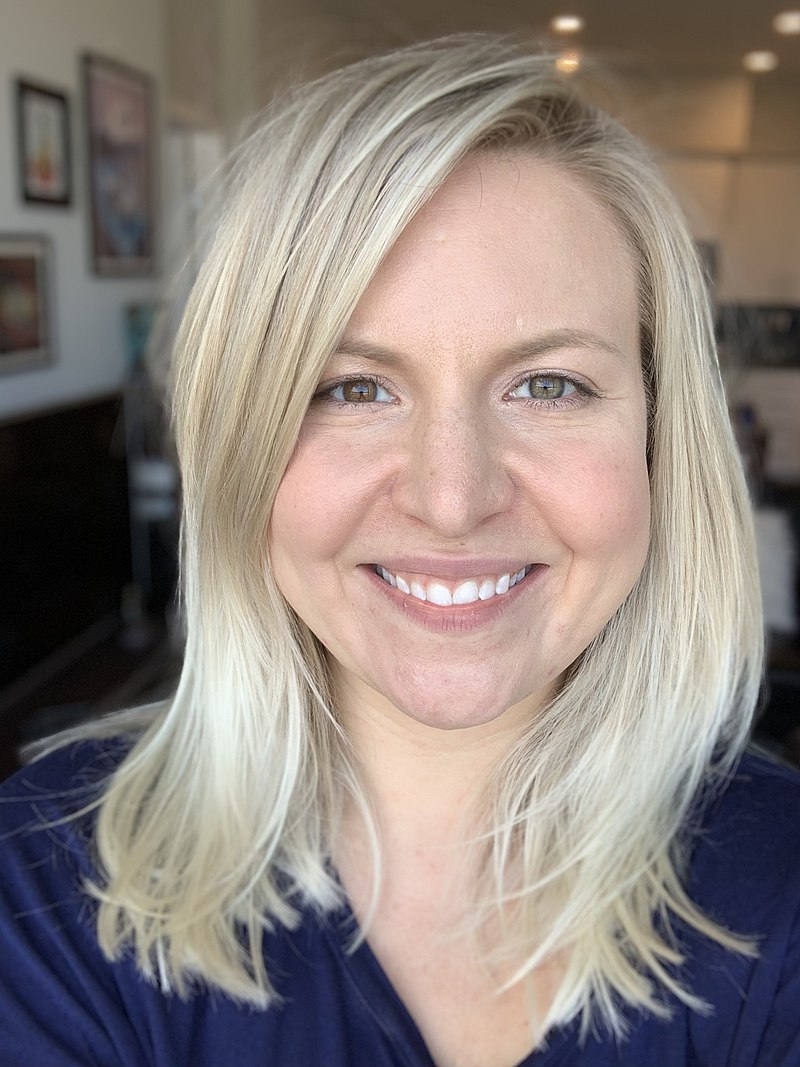
Ashley Gjovik is a lawyer, activist, author, and whistleblower. She blew the whistle on Apple in 2021.
Ashley specializes in human rights & the common good. She has a Bachelor of Science, Juris Doctor, and a Certificate in Public International Law with honors.
Ashley can be reached at ashleymgjovik@protonmail.com.



[…] in 1866 by Henri Nestlé, today the Nestlé corporation owns more than 2,000 brands.[1] Nestlé is the world’s largest food company and is one of the most multinational of […]
[…] https://covertactionmagazine.com/2023/02/07/nestles-blatant-misconduct-shows-us-the-darkness-of-capi…, […]
[…] https://covertactionmagazine.com/2023/02/07/nestles-blatant-misconduct-shows-us-the-darkness-of-capi… […]
Excelent. True is needed.
This is an excellent article describing all the terrible things that Nestle does. In this article I could not find any mention of the word capitalism, but the headline has the word capitalism So I am guessing that the writer may not disapprove of all capitalist corporations, but just those with bad business practises, as she never mentioned the word capitalism in her article.
Excellent article. I see the work you put into it. In today’s world, crime parades openly. Thank you for this work.